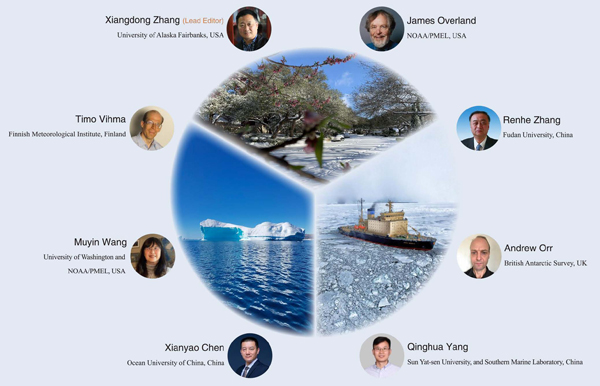Advances in Atmospheric Sciences
Changing Arctic Climate and Low/Mid-latitudes Connections
Call for papers
First Circular
Editorial Team:
Scope:
Significant changes have continually occurred in the Arctic climate system. During last four decades, the Arctic surface/lower troposphere warming rate has been more than two times the global average, leading to a phenomenon of the Arctic Amplification (AA). In particular, the warming trend was elevated during most recent decade, further enhancing AA.. At the same time, Arctic atmosphere and ocean dynamic processes have also exhibited noted changes, for example, the recently observed collapse of the winter Beaufort high, more intense Arctic synoptic cyclones, weakening of the stratospheric polar vortex, and warmed Atlantic and Pacific layer water. The Arctic changes do not occur independently within the Arctic. They respond to remote forcing in the tropical and midlatitudes and translate to the low/mid-latitude climate and weather anomalies. Great efforts have been made to improve understanding, simulation, and prediction/projection of Arctic changes and the two-way interactions between the Arctic and lower latitudes. Especially, several internationally coordinated observational and modeling projects have recently been carried out, such as the Year of Polar Prediction (YOPP), Multidisciplinary drifting Observatory for the Study of Arctic Climate (MOSAiC), and Polar Amplification Model Intercomparison Project (PAMIP).
This special issue will provide a platform to publish latest progresses on Arctic climate system changes and their responses to/impacts on low/mid-latitude climate and weather anomalies. The consolidated publications on the topic in this special issue would facilitate synthesis of new research results, identify key scientific gaps, and hence contribute to a more thorough understanding of the problem. Submissions in, but not limited to, the following research areas, are invited:
1) Observed and simulated multi-scale changes, phenomena, and physical/feedback processes in and across interface of the Arctic atmosphere, sea ice, and ocean in the past, present and future;
2) Detection and attribution of two-way connections through the atmosphere, sea ice, and ocean between Arctic climate changes and low/mid-latitude climate and weather, including extreme events;
3) Assessment of predictability and evaluation of biases, errors and uncertainties in model simulations and predictions
Important Dates:
Manuscript Submission Deadline: September 1, 2022.
Estimated publication time: Published online once accepted.
Final Print: Late winter 2022 or early 2023.
Submission URL: https://mc03.manuscriptcentral.com/aasiap
Please select: "Special issue: Arctic"
Please refer to the Author Guide for an MS Word template, Endnote reference style, and more detailed style instructions (http://www.iapjournals.ac.cn/aas/news/AuthorGuide.htm ).
Advances in Atmospheric Sciences (AAS), launched in 1984, aims to rapidly publish the latest achievements and developments on the dynamics, physics and chemistry of the Earth’s atmosphere and ocean. It also aims to rapidly publish potentially high influential papers on the atmospheres of other planets and on earth system dynamics in which the atmosphere and/or ocean are involved. AAS is published by Springer and indexed by SCI database. For more information about AAS, please visit https://www.springer.com/376.
Do feel free to contact us on aas@mail.iap.ac.cn if you have any queries regarding the special issue.

